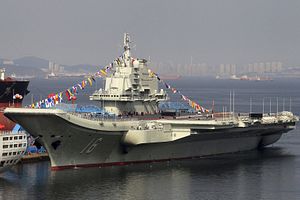The Chinese aircraft carrier Liaoning sailed south through the Taiwan Strait on Sunday, prompting Taiwan to scramble fighter jets and warships to monitor the Chinese ship and its escorts. The transit through the sensitive strait comes on the heel of announcements that the United States has authorized a $1.4 billion arms sale to Taiwan, which China considers a renegade province.
Taiwanese defense officials said the group of Chinese warships entered the strait Saturday afternoon and exited Sunday evening. The carrier and its escorts conducted extensive drills prior to entering the strait integrating air and surface ship operations and were reportedly overseen by the Chinese Navy’s political commissar, the PLAN’s second most senior officer.
Despite its proximity to the announced U.S.-Taiwan arms deal, the Liaoning’s transit has so far garnered less fraught news coverage than its previous strait transit in January, which the New York Times called “a defiant move.” I explained at the time why the Chinese carrier’s strait transit should not have been viewed as a provocation, and this most recent one shared many of the same key attributes.
First, the Liaoning is scheduled to make its first-ever port visit to Hong Kong on Friday as part of China’s celebrations marking the 20th anniversary of the former British colony’s handover back to China. While the Chinese carrier’s exact whereabouts since leaving its homeport in Qingdao on June 25 are unknown, it has not been reported to have transited through any of Japan’s southwest islands into the Western Pacific. This means that the Liaoning and her escorts likely remained in the Yellow and East China Sea and that her most direct route to the South China Sea and her port visit in Hong Kong was south through the Taiwan Strait, and therefore not a route obviously chosen to mainly to provoke Taiwan.
Second, just as it did in January, the Liaoning and her escorts stayed to the west of the Taiwan Strait’s centerline, which is to say while shadowed by Taiwanese ships and aircraft, the Chinese ships stayed on the mainland’s “side” of the strait. If China had intended to send an unambiguous signal or provocation with the transit, then the ships could have easily sailed on the Taiwan “side” to the east.
There was some rumor among China military watchers that the aircraft carrier’s arrival in Hong Kong could be delayed in order to make a patrol to the Paracel island group after a U.S. Navy destroyer conducted a freedom of navigation operation there on Sunday while the Liaoning was in the Taiwan Strait. However, this is unlikely. The Liaoning is a high-profile part of China’s Hong Kong handover celebrations, which have featured unprecedented shows of military might in the quasi self-governing Special Administrative Region. The carrier’s scheduled arrival on Friday also coincides with the 80th anniversary of the incident that sparked the Second Sino-Japanese War, and it is unlikely that authorities would want to sacrifice that political symbolism for a South China Sea patrol that would not obviously achieve anything.
China’s aircraft carrier program is the most public, high-profile face of its expanding fleet. Its second aircraft carrier, the Shandong, was launched in April and is set to enter service in 2020 once its final fitting out and trials are complete. The Shandong is a domestically-built, updated version of the Liaoning, which was originally a Ukrainian Kuznetsov-class aircraft carrier that China heavily refurbished and updated. China’s third aircraft carrier is under construction in Shanghai, and unlike the Liaoning and Shandong, is an indigenous design not based on the Soviet-era Kuznetsovs.

































